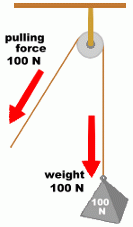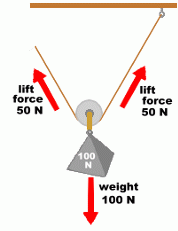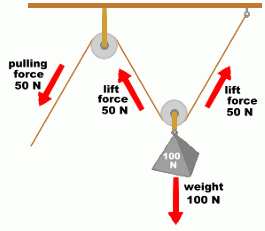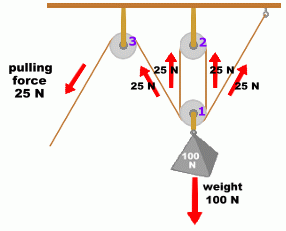

Here is a very simple pulley. The pulley is the wheel at the top. It's firmly attached to the ceiling, or other fixture above the object. The rope passes up around the pulley, and then heads back downwards. With one pulley, the force you must pull with is the same as the weight of the object. In order to raise the object a height of 1 metre, you must pull the rope 1 metre. This simple setup does have one advantage. You don't have to be above the object; you can stand beside it to lift it. Although you have to pull just as hard as without a pulley, being able to pull from the side is more convenient. But pulleys can also make the work easier ...  Here is another way that one pulley can be used to lift the object.
Here is another way that one pulley can be used to lift the object.The rope is anchored on the ceiling on the right, and passes down through the pulley, which is connected to the object. The rope then continues back upwards. The same 100 newton object is now being supported by two segments of rope. Each segment of rope only has to support half the weight ... they share the load. Half of the load, 50 newtons, is supported by the ceiling. The other 50 newtons is supported by you, pulling on the far end of the rope. You only have to pull half as hard. The disadvantages? You have to pull upwards. That isn't very convenient. And since you only have to work half as hard, you must pull twice as far! In order to lift the object a height of 1 metre, you must pull the rope 2 metres.  Here is the same setup as above, with one more pulley.
Here is the same setup as above, with one more pulley.This extra pulley doesn't make it easier to lift the object. It is used to reverse the direction of the pull. Now you can pull downwards, from the side. This is much more convenient. If you add more pulleys anchored to the ceiling, you can lessen the work you have to do even more. Every time you add another anchor, you cut the work in half, because you are sharing the load between two ropes. Have a look at the next diagram ... 
Here we are supporting the object with an additional pulley. There is still just one rope; it loops its way around each of the pulleys, sometimes twice. The rope is still anchored to the ceiling at the right. It runs down to the lower pulley 1, which as before is supporting the object. But now it takes a side trip. It heads up to pulley 2, and then back down again. Then it loops once more around pulley 1, and then heads over to pulley 3, and down to where you are pulling. By inserting the extra pulley, we have added two more segments of rope that are directly supporting the object. Now the weight of 100 newtons is supported by four rope segments, and they share the load, so each only has to pull with a force of 25 newtons. The single segment passing over the final pulley (which, once again, is there only to reverse the direction of the pull), is the one you pull on, with a pulling force of just 25 newtons. You only have to pull one quarter as hard. Of course, this time you will have to pull the rope 4 metres, in order to make the object lift 1 metre. This is the principle used in a block and tackle, a device made from pulleys for lifting or moving heavy objects. NOTE FOR PHYSICS STUDENTS: We are conveniently ignoring the fact that if you pull with a force exactly equal to the weight of the object, the object will be suspended, but won't move upwards. In fact, as you know, an additional small force must also be applied to accelerate the object upwards. This additional force is also lessened in the same proportion by the use of pulleys. We've also ignored force components, where a force applied at an angle, rather than straight up and down, will be larger. Both have been ignored here for the purpose of clarity. |
